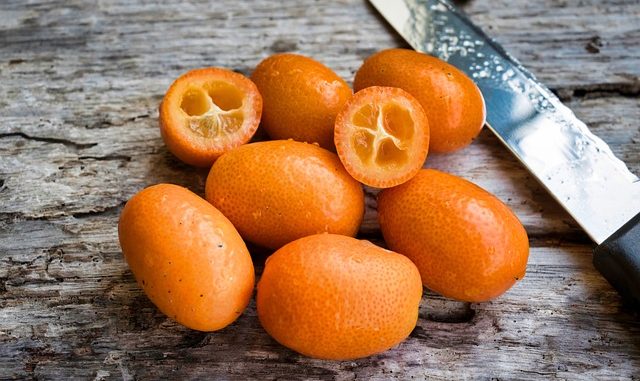
The genus Fortunella offers the exotic fruit connoisseur a fascinating range of new options. We are familiar now with at least three types all called kumquat. We have Nagami (F. margarita [Lour.] Swingle), Marumi (F. japonica [Thunb.] Swingle and Meiwa (F. crassifolia Swingle) which is actually a hybrid of the previous two species. All these fruits are now found in our shops. We also have F. polyandra and F. hindsii.
The word kumquat or cumquat and comquot originally came from the Chinese or Cantonese name of cam kwat (kin kü) which means ‘golden orange’. The fruit is closely allied to the Citrus genus of which all are seen as close relatives belonging to the Rutaceae family. In fact it is possible to obtain hybrids between both genus.
The name for the genus originally comes from Robert Fortune (1812-1880), who was a Scottish horticulturalist and plant explorer associated with the Royal Horticultural Society who brought the fruit into Europe.
Virtually all the kumquats are found in China and extensive cultivation has produced a wide range of hybrids (Huang et al., 2011). The fresh fruit is usually eaten raw but lends itself extremely well to processing into chutney, jam, liqueurs and sauces. The other major use is as a medicine where it has been used to treat respiratory complaints such as colds, coughs and flu and various forms of inflammation (Lin et al., 2008; Sadek et al., 2009). Further investigation into the antioxidant and antimicrobial activities of the extracts has become an important feature of investigation into its use as a dietary supplement (Jayaprakasha et al., 2012). The extract is claimed to reduce weight and other obesity-related metabolic disorders in mice (Tan et al., 2014). The fruit pericarp also activates cells which have a role in immunity development although there is still plenty of research to demonstrate action against infection (Nagahama et al., 2015).
The componentry has been investigated on many occasions. A dihydrochlacone derivative called 3′,5′-di-C-β-glucopyranosylphloretin and based on phloretin has been isolated (Ogawa et al., 2001). Thirteen flavonoids from F. japonica extracts were analysed using reverse-phase LC-DAD-ESI-ITMS. Acacetin 3,6-di-C-glucoside, vicenin-2, lucenin-2 4′-methyl ether, narirutin 4′-O-glucoside and apigenin 8-C-neohesperidoside were identified for the first time in kumquat juice (Barreca et al., 2011).
References
Barreca, D., Bellocco, E., Caristi, C., Leuzzi, U., & Gattuso, G. (2011). Kumquat (Fortunella japonica Swingle) juice: Flavonoid distribution and antioxidant properties. Food Research International, 44(7), pp. 2190-2197.
Huang, G., Liying, G., Zhang, S., He, X., Zhou, R., Chen, H., Yang, C. (2011) Genetic relationship analysis of Fortunella germplasm resources from China and Vietnam by ISSR markers. J. Fruit Sci. 28(4) pp. 563–7
Jayaprakasha G, Murthy KC, Etlinger M, Mantur SM, Patil BS. 2012. Radical scavenging capacities and inhibition of human prostate (LNCaP) cell proliferation by Fortunella margarita. Food Chem. 131(1) pp. 184–91.
Lin, C.C., Hung, P.F., Ho, S.C. (2008) Heat treatment enhances the NO-suppressing and peroxynitrite-intercepting activities of kumquat (Fortunella margarita Swingle) peel. Food Chem. 109(1) pp. 95–103
Nagahama, K., Eto, N., Shimojo, T., Kondoh, T., Nakahara, K., Sakakibara, Y., Fukui, K., Suiko, M. (2015) Effect of kumquat (Fortunella crassifolia) pericarp on natural killer cell activity in vitro and in vivo. Biosci. Biotechnol. Biochem. pp. 1–10
Ogawa, K., Kawasaki, A., Omura, M., Yoshida, T., Ikoma, Y., & Yano, M. (2001). 3′, 5′-Di-C-β-glucopyranosylphloretin, a flavonoid characteristic of the genus Fortunella. Phytochemistry, 57(5), pp. 737-742.
Sadek, E.S., Makris, D.P., Kefalas, P. (2009) Polyphenolic composition and antioxidant characteristics of kumquat (Fortunella margarita) peel fractions. Plant Foods Hum. Nutr. 64(4) pp. 297–302
Tan, S., Li, M., Ding, X., Fan, S., Guo, L., Gu, M., Zhang, Y., Feng, L., Jiang, D., Li, Y. (2014) Effects of Fortunella margarita fruit extract on metabolic disorders in high-fat diet-induced obese C57BL/6 mice. PloS One 9(4):e93510.
Leave a Reply